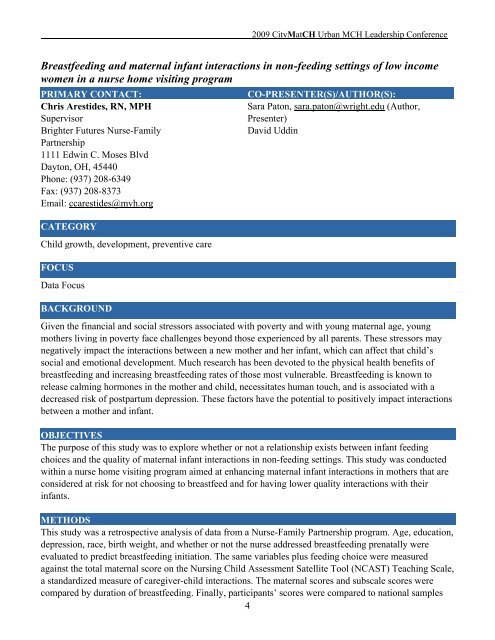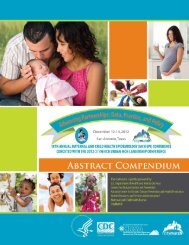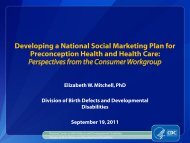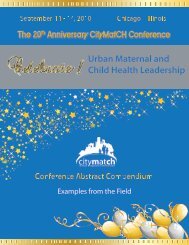Conference Abstract Compendium Examples from the ... - CityMatCH
Conference Abstract Compendium Examples from the ... - CityMatCH
Conference Abstract Compendium Examples from the ... - CityMatCH
You also want an ePaper? Increase the reach of your titles
YUMPU automatically turns print PDFs into web optimized ePapers that Google loves.
2009 <strong>CityMatCH</strong> Urban MCH Leadership <strong>Conference</strong>Breastfeeding and maternal infant interactions in non-feeding settings of low incomewomen in a nurse home visiting programPRIMARY CONTACT:Chris Arestides, RN, MPHSupervisorBrighter Futures Nurse-FamilyPartnership1111 Edwin C. Moses BlvdDayton, OH, 45440Phone: (937) 208-6349Fax: (937) 208-8373Email: ccarestides@mvh.orgCATEGORYChild growth, development, preventive careFOCUSData FocusBACKGROUNDCO-PRESENTER(S)/AUTHOR(S):Sara Paton, sara.paton@wright.edu (Author,Presenter)David UddinGiven <strong>the</strong> financial and social stressors associated with poverty and with young maternal age, youngmo<strong>the</strong>rs living in poverty face challenges beyond those experienced by all parents. These stressors maynegatively impact <strong>the</strong> interactions between a new mo<strong>the</strong>r and her infant, which can affect that child’ssocial and emotional development. Much research has been devoted to <strong>the</strong> physical health benefits ofbreastfeeding and increasing breastfeeding rates of those most vulnerable. Breastfeeding is known torelease calming hormones in <strong>the</strong> mo<strong>the</strong>r and child, necessitates human touch, and is associated with adecreased risk of postpartum depression. These factors have <strong>the</strong> potential to positively impact interactionsbetween a mo<strong>the</strong>r and infant.OBJECTIVESThe purpose of this study was to explore whe<strong>the</strong>r or not a relationship exists between infant feedingchoices and <strong>the</strong> quality of maternal infant interactions in non-feeding settings. This study was conductedwithin a nurse home visiting program aimed at enhancing maternal infant interactions in mo<strong>the</strong>rs that areconsidered at risk for not choosing to breastfeed and for having lower quality interactions with <strong>the</strong>irinfants.METHODSThis study was a retrospective analysis of data <strong>from</strong> a Nurse-Family Partnership program. Age, education,depression, race, birth weight, and whe<strong>the</strong>r or not <strong>the</strong> nurse addressed breastfeeding prenatally wereevaluated to predict breastfeeding initiation. The same variables plus feeding choice were measuredagainst <strong>the</strong> total maternal score on <strong>the</strong> Nursing Child Assessment Satellite Tool (NCAST) Teaching Scale,a standardized measure of caregiver-child interactions. The maternal scores and subscale scores werecompared by duration of breastfeeding. Finally, participants’ scores were compared to national samples4







